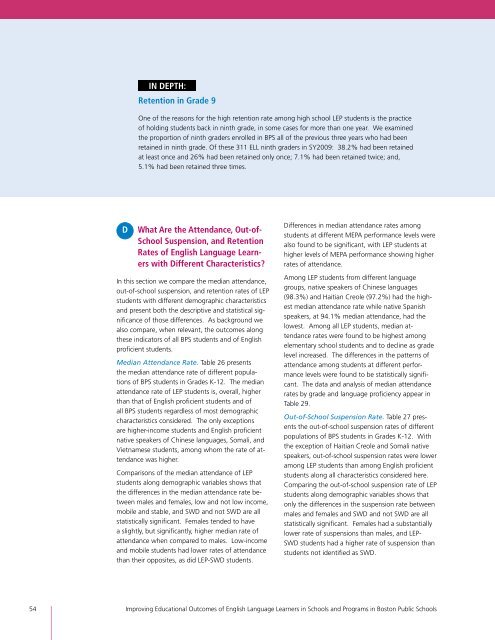Full Report - Center for Collaborative Education
Full Report - Center for Collaborative Education
Full Report - Center for Collaborative Education
Create successful ePaper yourself
Turn your PDF publications into a flip-book with our unique Google optimized e-Paper software.
IN DEPTH:<br />
Retention in Grade 9<br />
One of the reasons <strong>for</strong> the high retention rate among high school LEP students is the practice<br />
of holding students back in ninth grade, in some cases <strong>for</strong> more than one year. We examined<br />
the proportion of ninth graders enrolled in BPS all of the previous three years who had been<br />
retained in ninth grade. Of these 311 ELL ninth graders in SY2009: 38.2% had been retained<br />
at least once and 26% had been retained only once; 7.1% had been retained twice; and,<br />
5.1% had been retained three times.<br />
D What Are the Attendance, Out-of-<br />
School Suspension, and Retention<br />
Rates of English Language Learners<br />
with Different Characteristics?<br />
In this section we compare the median attendance,<br />
out-of-school suspension, and retention rates of LEP<br />
students with different demographic characteristics<br />
and present both the descriptive and statistical significance<br />
of those differences. As background we<br />
also compare, when relevant, the outcomes along<br />
these indicators of all BPS students and of English<br />
proficient students.<br />
Median Attendance Rate. Table 26 presents<br />
the median attendance rate of different populations<br />
of BPS students in Grades K-12. The median<br />
attendance rate of LEP students is, overall, higher<br />
than that of English proficient students and of<br />
all BPS students regardless of most demographic<br />
characteristics considered. The only exceptions<br />
are higher-income students and English proficient<br />
native speakers of Chinese languages, Somali, and<br />
Vietnamese students, among whom the rate of attendance<br />
was higher.<br />
Comparisons of the median attendance of LEP<br />
students along demographic variables shows that<br />
the differences in the median attendance rate between<br />
males and females, low and not low income,<br />
mobile and stable, and SWD and not SWD are all<br />
statistically significant. Females tended to have<br />
a slightly, but significantly, higher median rate of<br />
attendance when compared to males. Low-income<br />
and mobile students had lower rates of attendance<br />
than their opposites, as did LEP-SWD students.<br />
Differences in median attendance rates among<br />
students at different MEPA per<strong>for</strong>mance levels were<br />
also found to be significant, with LEP students at<br />
higher levels of MEPA per<strong>for</strong>mance showing higher<br />
rates of attendance.<br />
Among LEP students from different language<br />
groups, native speakers of Chinese languages<br />
(98.3%) and Haitian Creole (97.2%) had the highest<br />
median attendance rate while native Spanish<br />
speakers, at 94.1% median attendance, had the<br />
lowest. Among all LEP students, median attendance<br />
rates were found to be highest among<br />
elementary school students and to decline as grade<br />
level increased. The differences in the patterns of<br />
attendance among students at different per<strong>for</strong>mance<br />
levels were found to be statistically significant.<br />
The data and analysis of median attendance<br />
rates by grade and language proficiency appear in<br />
Table 29.<br />
Out-of-School Suspension Rate. Table 27 presents<br />
the out-of-school suspension rates of different<br />
populations of BPS students in Grades K-12. With<br />
the exception of Haitian Creole and Somali native<br />
speakers, out-of-school suspension rates were lower<br />
among LEP students than among English proficient<br />
students along all characteristics considered here.<br />
Comparing the out-of-school suspension rate of LEP<br />
students along demographic variables shows that<br />
only the differences in the suspension rate between<br />
males and females and SWD and not SWD are all<br />
statistically significant. Females had a substantially<br />
lower rate of suspensions than males, and LEP-<br />
SWD students had a higher rate of suspension than<br />
students not identified as SWD.<br />
54 Improving <strong>Education</strong>al Outcomes of English Language Learners in Schools and Programs in Boston Public Schools


